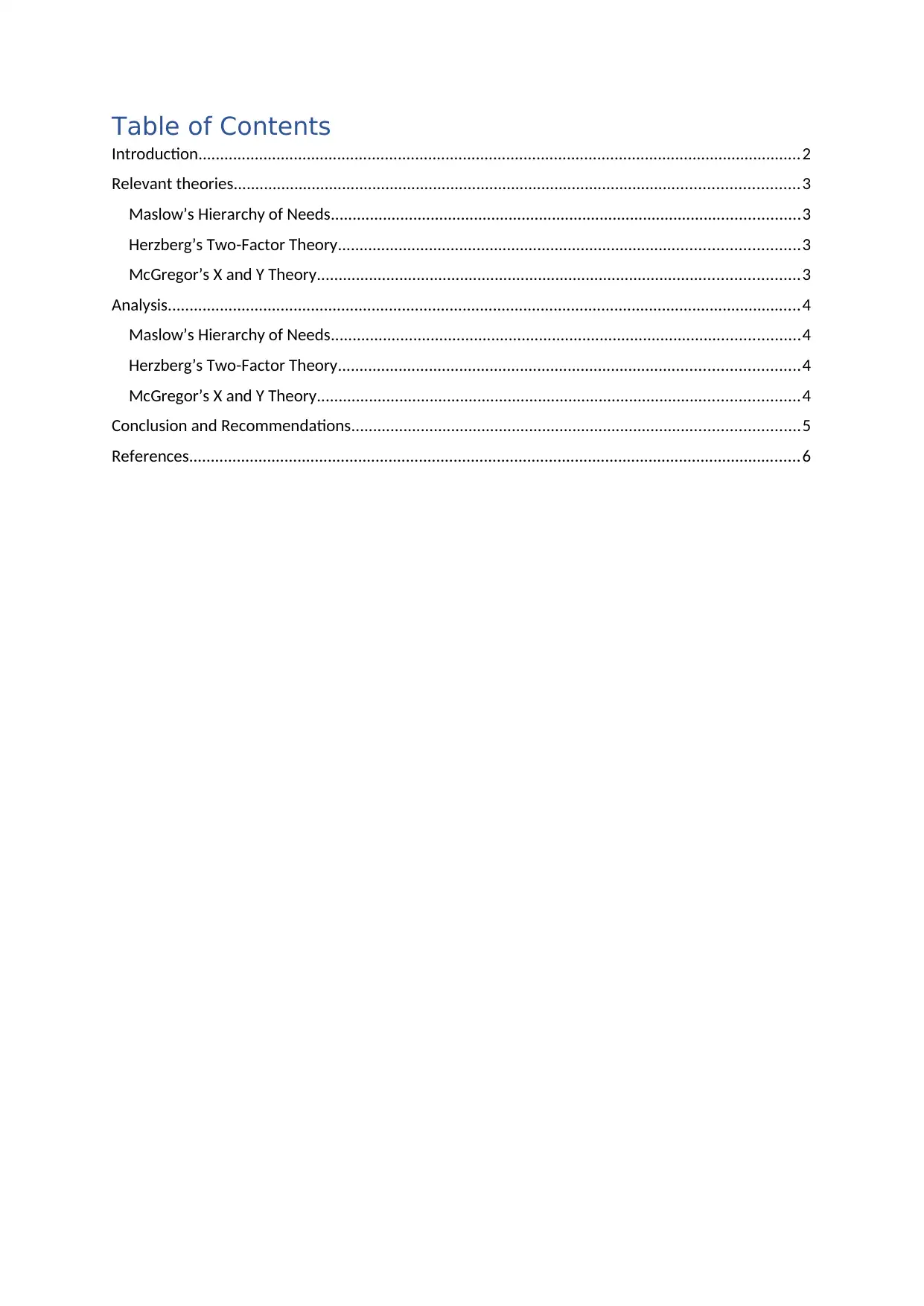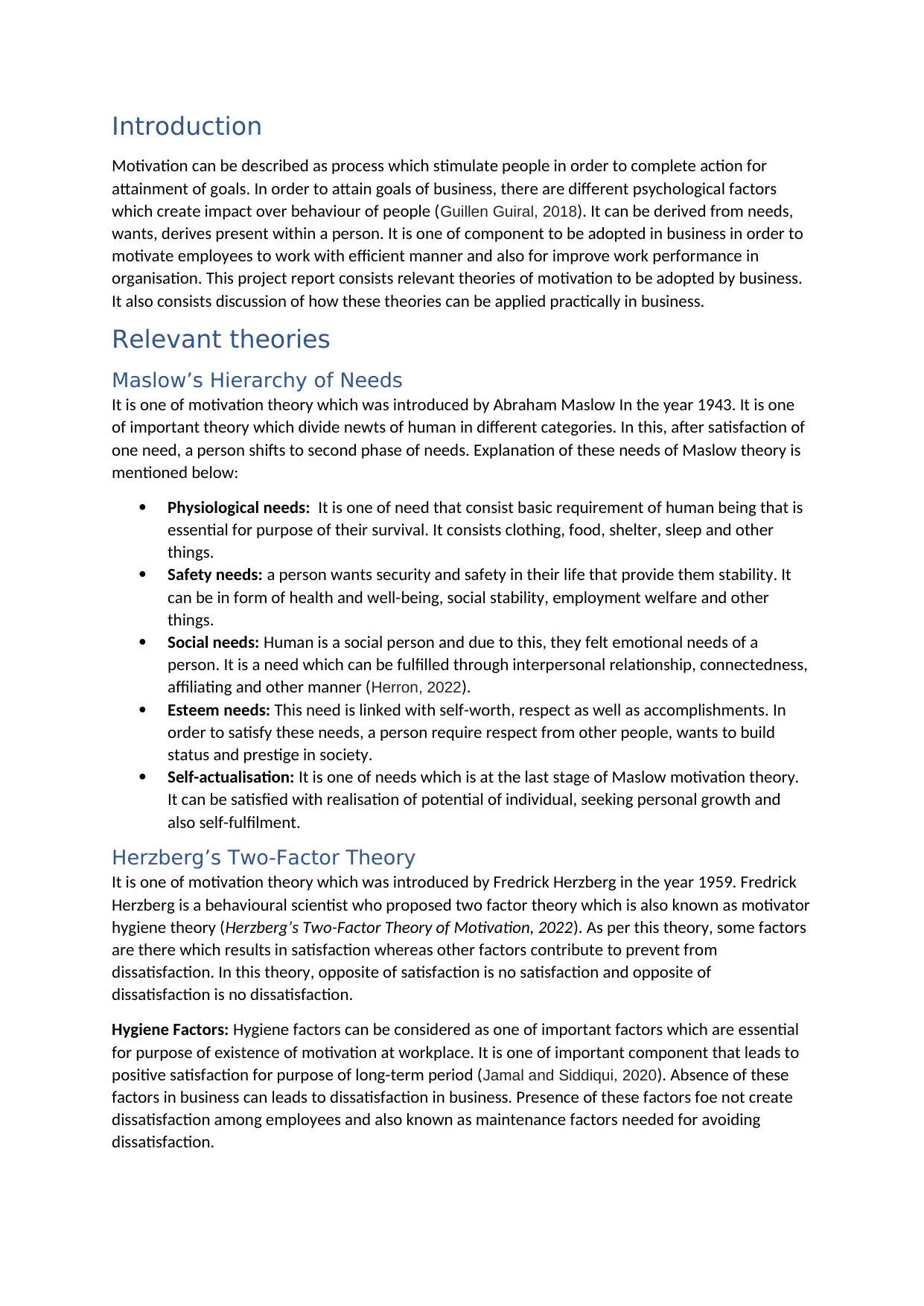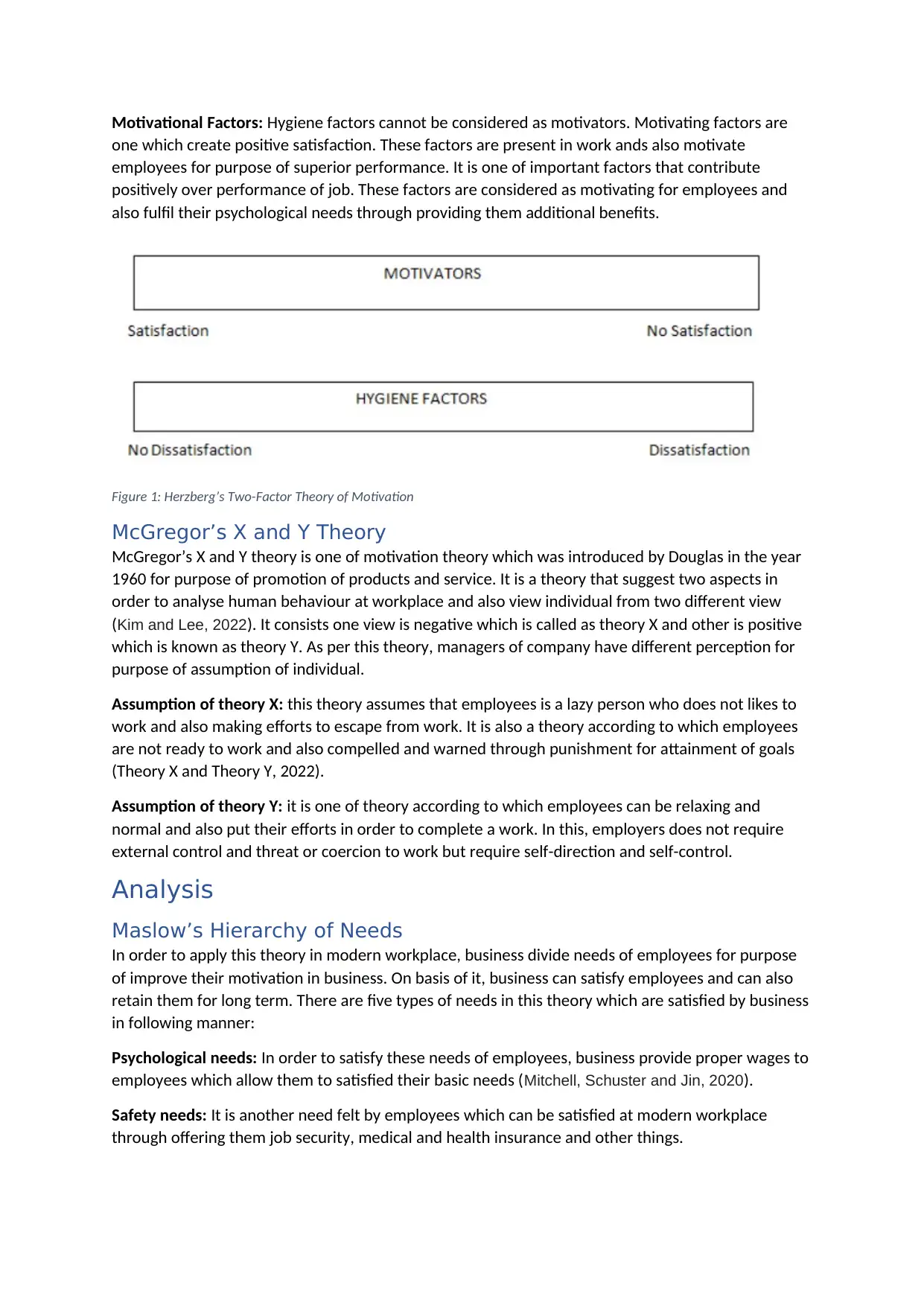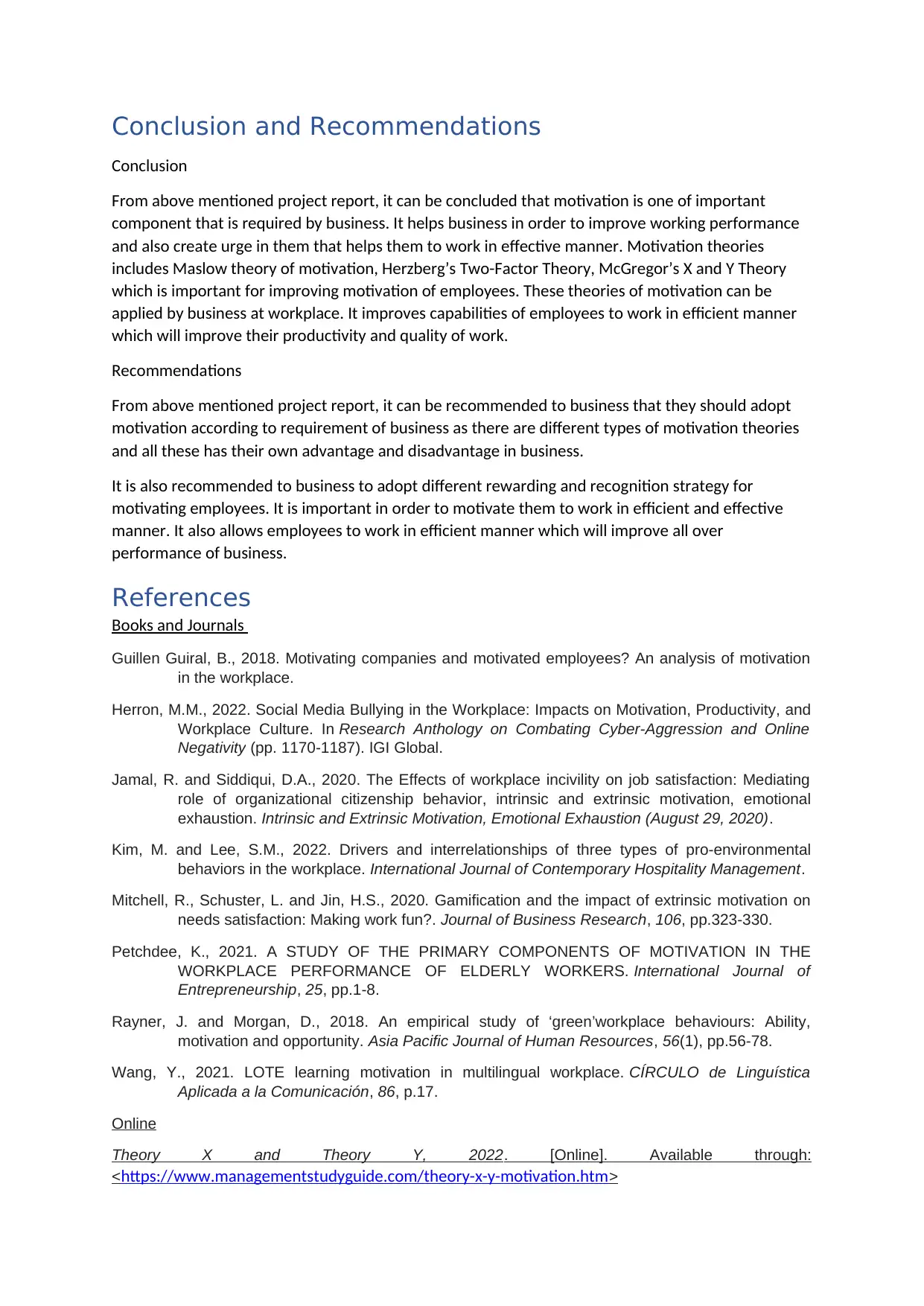Module: Managing People and Systems - Individual Essay on Motivation
VerifiedAdded on 2023/06/10
|7
|2152
|170
Essay
AI Summary
This essay delves into the realm of motivation theories within the context of managing people and systems. It begins with an introduction to the concept of motivation and its significance in achieving organizational goals. The essay then explores three prominent theories: Maslow's Hierarchy of Needs, Herzberg's Two-Factor Theory, and McGregor's X and Y Theory. Each theory is explained in detail, outlining its core principles and components. The analysis section examines the practical application of these theories in a modern workplace, discussing how businesses can utilize them to enhance employee motivation, satisfaction, and overall performance. The essay concludes with a summary of the key findings and provides recommendations for businesses to effectively implement motivation strategies. The essay is supported by relevant references to academic journals and online resources.

Cover Page
Student Name:
Student ID:
Module Name: Managing People and Systems
Assessment 2: Individual Essay
Lecturer Name:
Student Name:
Student ID:
Module Name: Managing People and Systems
Assessment 2: Individual Essay
Lecturer Name:
Paraphrase This Document
Need a fresh take? Get an instant paraphrase of this document with our AI Paraphraser

Table of Contents
Introduction...........................................................................................................................................2
Relevant theories..................................................................................................................................3
Maslow’s Hierarchy of Needs............................................................................................................3
Herzberg’s Two-Factor Theory..........................................................................................................3
McGregor’s X and Y Theory...............................................................................................................3
Analysis..................................................................................................................................................4
Maslow’s Hierarchy of Needs............................................................................................................4
Herzberg’s Two-Factor Theory..........................................................................................................4
McGregor’s X and Y Theory...............................................................................................................4
Conclusion and Recommendations.......................................................................................................5
References.............................................................................................................................................6
Introduction...........................................................................................................................................2
Relevant theories..................................................................................................................................3
Maslow’s Hierarchy of Needs............................................................................................................3
Herzberg’s Two-Factor Theory..........................................................................................................3
McGregor’s X and Y Theory...............................................................................................................3
Analysis..................................................................................................................................................4
Maslow’s Hierarchy of Needs............................................................................................................4
Herzberg’s Two-Factor Theory..........................................................................................................4
McGregor’s X and Y Theory...............................................................................................................4
Conclusion and Recommendations.......................................................................................................5
References.............................................................................................................................................6

Introduction
Motivation can be described as process which stimulate people in order to complete action for
attainment of goals. In order to attain goals of business, there are different psychological factors
which create impact over behaviour of people (Guillen Guiral, 2018). It can be derived from needs,
wants, derives present within a person. It is one of component to be adopted in business in order to
motivate employees to work with efficient manner and also for improve work performance in
organisation. This project report consists relevant theories of motivation to be adopted by business.
It also consists discussion of how these theories can be applied practically in business.
Relevant theories
Maslow’s Hierarchy of Needs
It is one of motivation theory which was introduced by Abraham Maslow In the year 1943. It is one
of important theory which divide newts of human in different categories. In this, after satisfaction of
one need, a person shifts to second phase of needs. Explanation of these needs of Maslow theory is
mentioned below:
Physiological needs: It is one of need that consist basic requirement of human being that is
essential for purpose of their survival. It consists clothing, food, shelter, sleep and other
things.
Safety needs: a person wants security and safety in their life that provide them stability. It
can be in form of health and well-being, social stability, employment welfare and other
things.
Social needs: Human is a social person and due to this, they felt emotional needs of a
person. It is a need which can be fulfilled through interpersonal relationship, connectedness,
affiliating and other manner (Herron, 2022).
Esteem needs: This need is linked with self-worth, respect as well as accomplishments. In
order to satisfy these needs, a person require respect from other people, wants to build
status and prestige in society.
Self-actualisation: It is one of needs which is at the last stage of Maslow motivation theory.
It can be satisfied with realisation of potential of individual, seeking personal growth and
also self-fulfilment.
Herzberg’s Two-Factor Theory
It is one of motivation theory which was introduced by Fredrick Herzberg in the year 1959. Fredrick
Herzberg is a behavioural scientist who proposed two factor theory which is also known as motivator
hygiene theory (Herzberg’s Two-Factor Theory of Motivation, 2022). As per this theory, some factors
are there which results in satisfaction whereas other factors contribute to prevent from
dissatisfaction. In this theory, opposite of satisfaction is no satisfaction and opposite of
dissatisfaction is no dissatisfaction.
Hygiene Factors: Hygiene factors can be considered as one of important factors which are essential
for purpose of existence of motivation at workplace. It is one of important component that leads to
positive satisfaction for purpose of long-term period (Jamal and Siddiqui, 2020). Absence of these
factors in business can leads to dissatisfaction in business. Presence of these factors foe not create
dissatisfaction among employees and also known as maintenance factors needed for avoiding
dissatisfaction.
Motivation can be described as process which stimulate people in order to complete action for
attainment of goals. In order to attain goals of business, there are different psychological factors
which create impact over behaviour of people (Guillen Guiral, 2018). It can be derived from needs,
wants, derives present within a person. It is one of component to be adopted in business in order to
motivate employees to work with efficient manner and also for improve work performance in
organisation. This project report consists relevant theories of motivation to be adopted by business.
It also consists discussion of how these theories can be applied practically in business.
Relevant theories
Maslow’s Hierarchy of Needs
It is one of motivation theory which was introduced by Abraham Maslow In the year 1943. It is one
of important theory which divide newts of human in different categories. In this, after satisfaction of
one need, a person shifts to second phase of needs. Explanation of these needs of Maslow theory is
mentioned below:
Physiological needs: It is one of need that consist basic requirement of human being that is
essential for purpose of their survival. It consists clothing, food, shelter, sleep and other
things.
Safety needs: a person wants security and safety in their life that provide them stability. It
can be in form of health and well-being, social stability, employment welfare and other
things.
Social needs: Human is a social person and due to this, they felt emotional needs of a
person. It is a need which can be fulfilled through interpersonal relationship, connectedness,
affiliating and other manner (Herron, 2022).
Esteem needs: This need is linked with self-worth, respect as well as accomplishments. In
order to satisfy these needs, a person require respect from other people, wants to build
status and prestige in society.
Self-actualisation: It is one of needs which is at the last stage of Maslow motivation theory.
It can be satisfied with realisation of potential of individual, seeking personal growth and
also self-fulfilment.
Herzberg’s Two-Factor Theory
It is one of motivation theory which was introduced by Fredrick Herzberg in the year 1959. Fredrick
Herzberg is a behavioural scientist who proposed two factor theory which is also known as motivator
hygiene theory (Herzberg’s Two-Factor Theory of Motivation, 2022). As per this theory, some factors
are there which results in satisfaction whereas other factors contribute to prevent from
dissatisfaction. In this theory, opposite of satisfaction is no satisfaction and opposite of
dissatisfaction is no dissatisfaction.
Hygiene Factors: Hygiene factors can be considered as one of important factors which are essential
for purpose of existence of motivation at workplace. It is one of important component that leads to
positive satisfaction for purpose of long-term period (Jamal and Siddiqui, 2020). Absence of these
factors in business can leads to dissatisfaction in business. Presence of these factors foe not create
dissatisfaction among employees and also known as maintenance factors needed for avoiding
dissatisfaction.
⊘ This is a preview!⊘
Do you want full access?
Subscribe today to unlock all pages.

Trusted by 1+ million students worldwide

Motivational Factors: Hygiene factors cannot be considered as motivators. Motivating factors are
one which create positive satisfaction. These factors are present in work ands also motivate
employees for purpose of superior performance. It is one of important factors that contribute
positively over performance of job. These factors are considered as motivating for employees and
also fulfil their psychological needs through providing them additional benefits.
Figure 1: Herzberg’s Two-Factor Theory of Motivation
McGregor’s X and Y Theory
McGregor’s X and Y theory is one of motivation theory which was introduced by Douglas in the year
1960 for purpose of promotion of products and service. It is a theory that suggest two aspects in
order to analyse human behaviour at workplace and also view individual from two different view
(Kim and Lee, 2022). It consists one view is negative which is called as theory X and other is positive
which is known as theory Y. As per this theory, managers of company have different perception for
purpose of assumption of individual.
Assumption of theory X: this theory assumes that employees is a lazy person who does not likes to
work and also making efforts to escape from work. It is also a theory according to which employees
are not ready to work and also compelled and warned through punishment for attainment of goals
(Theory X and Theory Y, 2022).
Assumption of theory Y: it is one of theory according to which employees can be relaxing and
normal and also put their efforts in order to complete a work. In this, employers does not require
external control and threat or coercion to work but require self-direction and self-control.
Analysis
Maslow’s Hierarchy of Needs
In order to apply this theory in modern workplace, business divide needs of employees for purpose
of improve their motivation in business. On basis of it, business can satisfy employees and can also
retain them for long term. There are five types of needs in this theory which are satisfied by business
in following manner:
Psychological needs: In order to satisfy these needs of employees, business provide proper wages to
employees which allow them to satisfied their basic needs (Mitchell, Schuster and Jin, 2020).
Safety needs: It is another need felt by employees which can be satisfied at modern workplace
through offering them job security, medical and health insurance and other things.
one which create positive satisfaction. These factors are present in work ands also motivate
employees for purpose of superior performance. It is one of important factors that contribute
positively over performance of job. These factors are considered as motivating for employees and
also fulfil their psychological needs through providing them additional benefits.
Figure 1: Herzberg’s Two-Factor Theory of Motivation
McGregor’s X and Y Theory
McGregor’s X and Y theory is one of motivation theory which was introduced by Douglas in the year
1960 for purpose of promotion of products and service. It is a theory that suggest two aspects in
order to analyse human behaviour at workplace and also view individual from two different view
(Kim and Lee, 2022). It consists one view is negative which is called as theory X and other is positive
which is known as theory Y. As per this theory, managers of company have different perception for
purpose of assumption of individual.
Assumption of theory X: this theory assumes that employees is a lazy person who does not likes to
work and also making efforts to escape from work. It is also a theory according to which employees
are not ready to work and also compelled and warned through punishment for attainment of goals
(Theory X and Theory Y, 2022).
Assumption of theory Y: it is one of theory according to which employees can be relaxing and
normal and also put their efforts in order to complete a work. In this, employers does not require
external control and threat or coercion to work but require self-direction and self-control.
Analysis
Maslow’s Hierarchy of Needs
In order to apply this theory in modern workplace, business divide needs of employees for purpose
of improve their motivation in business. On basis of it, business can satisfy employees and can also
retain them for long term. There are five types of needs in this theory which are satisfied by business
in following manner:
Psychological needs: In order to satisfy these needs of employees, business provide proper wages to
employees which allow them to satisfied their basic needs (Mitchell, Schuster and Jin, 2020).
Safety needs: It is another need felt by employees which can be satisfied at modern workplace
through offering them job security, medical and health insurance and other things.
Paraphrase This Document
Need a fresh take? Get an instant paraphrase of this document with our AI Paraphraser

Social needs: This need of employees can be satisfied with allowing them to develop informal group.
It is important in business as it helps employees to feel comfortable at workplace.
Esteem needs: Esteem needs can be satisfied by business by rewarding employees and providing
them recognition for their hard work and also for their efforts for business.
Self-actualisation: It is the last needs of Maslow hexarchy which can be satisfied by business by
offering promotion, transfer, appraisal at workplace.
Herzberg’s Two-Factor Theory
Herzberg motivation theory is also a motivation theory which can be adopted by modern
organisation in order to improve motivation of employees. It is important in order to improve
satisfaction of employees and also prevent them from dissatisfaction at workplace.
Hygiene factors: It is one of factor that is essential in order to prevent factors that leads to
dissatisfaction among employees. Components included in this are mentioned below:
Pay is one of important factors that will prevent dissatisfaction among employees as it is
important for a business to provide competitive and appropriate pay to employees who are
working hard in business (Petchdee, 2021).
Policy of company and administration should not also be rigid as it also creates
dissatisfaction among employees. In order to satisfied this need, business needs to offer
flexible working hours, dress code, breaks and vacation to employees.
Business can also offer job security, plosive working condition to employees in order to
improve their satisfaction as it will improve their health and also prevent dissatisfaction
among them.
Motivational factors: It is one of factors that contribute to satisfaction of employees. In order to
satisfied these needs, business offer different things which are mentioned below:
Recognition: Managers of company provide recognition opportunity to employees in order
to improve their motivation. In this, work of employee is praised and recognised by
managers for their work.
Promotional opportunities: Employees wants advancement and growth opportunities at workplace
and it is important for company to provide them opportunities in order to keep employees
motivated at workplace (Rayner and Morgan, 2018).
Responsibilities: It is another important component that is required by individual for
purpose of getting ownership in work.
McGregor’s X and Y Theory
It is one of theory which is important in order to understand human behaviour of individual. It is also
important in order to understand perception of managers. In order to motivate employees,
individual needs to follow different assumptions which are mentioned below:
For adopting theory X, managers of company need to use control and supervision of
company. In this, employees do not accept change due to which innovation cannot be
promoted in business (Wang, 2021).
For adopting theory Y, managers of company need to encourage working environment that
provide opportunity to employee for taking initiatives and also for self-direction.
It is important in business as it helps employees to feel comfortable at workplace.
Esteem needs: Esteem needs can be satisfied by business by rewarding employees and providing
them recognition for their hard work and also for their efforts for business.
Self-actualisation: It is the last needs of Maslow hexarchy which can be satisfied by business by
offering promotion, transfer, appraisal at workplace.
Herzberg’s Two-Factor Theory
Herzberg motivation theory is also a motivation theory which can be adopted by modern
organisation in order to improve motivation of employees. It is important in order to improve
satisfaction of employees and also prevent them from dissatisfaction at workplace.
Hygiene factors: It is one of factor that is essential in order to prevent factors that leads to
dissatisfaction among employees. Components included in this are mentioned below:
Pay is one of important factors that will prevent dissatisfaction among employees as it is
important for a business to provide competitive and appropriate pay to employees who are
working hard in business (Petchdee, 2021).
Policy of company and administration should not also be rigid as it also creates
dissatisfaction among employees. In order to satisfied this need, business needs to offer
flexible working hours, dress code, breaks and vacation to employees.
Business can also offer job security, plosive working condition to employees in order to
improve their satisfaction as it will improve their health and also prevent dissatisfaction
among them.
Motivational factors: It is one of factors that contribute to satisfaction of employees. In order to
satisfied these needs, business offer different things which are mentioned below:
Recognition: Managers of company provide recognition opportunity to employees in order
to improve their motivation. In this, work of employee is praised and recognised by
managers for their work.
Promotional opportunities: Employees wants advancement and growth opportunities at workplace
and it is important for company to provide them opportunities in order to keep employees
motivated at workplace (Rayner and Morgan, 2018).
Responsibilities: It is another important component that is required by individual for
purpose of getting ownership in work.
McGregor’s X and Y Theory
It is one of theory which is important in order to understand human behaviour of individual. It is also
important in order to understand perception of managers. In order to motivate employees,
individual needs to follow different assumptions which are mentioned below:
For adopting theory X, managers of company need to use control and supervision of
company. In this, employees do not accept change due to which innovation cannot be
promoted in business (Wang, 2021).
For adopting theory Y, managers of company need to encourage working environment that
provide opportunity to employee for taking initiatives and also for self-direction.

Conclusion and Recommendations
Conclusion
From above mentioned project report, it can be concluded that motivation is one of important
component that is required by business. It helps business in order to improve working performance
and also create urge in them that helps them to work in effective manner. Motivation theories
includes Maslow theory of motivation, Herzberg’s Two-Factor Theory, McGregor’s X and Y Theory
which is important for improving motivation of employees. These theories of motivation can be
applied by business at workplace. It improves capabilities of employees to work in efficient manner
which will improve their productivity and quality of work.
Recommendations
From above mentioned project report, it can be recommended to business that they should adopt
motivation according to requirement of business as there are different types of motivation theories
and all these has their own advantage and disadvantage in business.
It is also recommended to business to adopt different rewarding and recognition strategy for
motivating employees. It is important in order to motivate them to work in efficient and effective
manner. It also allows employees to work in efficient manner which will improve all over
performance of business.
References
Books and Journals
Guillen Guiral, B., 2018. Motivating companies and motivated employees? An analysis of motivation
in the workplace.
Herron, M.M., 2022. Social Media Bullying in the Workplace: Impacts on Motivation, Productivity, and
Workplace Culture. In Research Anthology on Combating Cyber-Aggression and Online
Negativity (pp. 1170-1187). IGI Global.
Jamal, R. and Siddiqui, D.A., 2020. The Effects of workplace incivility on job satisfaction: Mediating
role of organizational citizenship behavior, intrinsic and extrinsic motivation, emotional
exhaustion. Intrinsic and Extrinsic Motivation, Emotional Exhaustion (August 29, 2020).
Kim, M. and Lee, S.M., 2022. Drivers and interrelationships of three types of pro-environmental
behaviors in the workplace. International Journal of Contemporary Hospitality Management.
Mitchell, R., Schuster, L. and Jin, H.S., 2020. Gamification and the impact of extrinsic motivation on
needs satisfaction: Making work fun?. Journal of Business Research, 106, pp.323-330.
Petchdee, K., 2021. A STUDY OF THE PRIMARY COMPONENTS OF MOTIVATION IN THE
WORKPLACE PERFORMANCE OF ELDERLY WORKERS. International Journal of
Entrepreneurship, 25, pp.1-8.
Rayner, J. and Morgan, D., 2018. An empirical study of ‘green’workplace behaviours: Ability,
motivation and opportunity. Asia Pacific Journal of Human Resources, 56(1), pp.56-78.
Wang, Y., 2021. LOTE learning motivation in multilingual workplace. CÍRCULO de Linguística
Aplicada a la Comunicación , 86, p.17.
Online
Theory X and Theory Y, 2022. [Online]. Available through:
<https://www.managementstudyguide.com/theory-x-y-motivation.htm>
Conclusion
From above mentioned project report, it can be concluded that motivation is one of important
component that is required by business. It helps business in order to improve working performance
and also create urge in them that helps them to work in effective manner. Motivation theories
includes Maslow theory of motivation, Herzberg’s Two-Factor Theory, McGregor’s X and Y Theory
which is important for improving motivation of employees. These theories of motivation can be
applied by business at workplace. It improves capabilities of employees to work in efficient manner
which will improve their productivity and quality of work.
Recommendations
From above mentioned project report, it can be recommended to business that they should adopt
motivation according to requirement of business as there are different types of motivation theories
and all these has their own advantage and disadvantage in business.
It is also recommended to business to adopt different rewarding and recognition strategy for
motivating employees. It is important in order to motivate them to work in efficient and effective
manner. It also allows employees to work in efficient manner which will improve all over
performance of business.
References
Books and Journals
Guillen Guiral, B., 2018. Motivating companies and motivated employees? An analysis of motivation
in the workplace.
Herron, M.M., 2022. Social Media Bullying in the Workplace: Impacts on Motivation, Productivity, and
Workplace Culture. In Research Anthology on Combating Cyber-Aggression and Online
Negativity (pp. 1170-1187). IGI Global.
Jamal, R. and Siddiqui, D.A., 2020. The Effects of workplace incivility on job satisfaction: Mediating
role of organizational citizenship behavior, intrinsic and extrinsic motivation, emotional
exhaustion. Intrinsic and Extrinsic Motivation, Emotional Exhaustion (August 29, 2020).
Kim, M. and Lee, S.M., 2022. Drivers and interrelationships of three types of pro-environmental
behaviors in the workplace. International Journal of Contemporary Hospitality Management.
Mitchell, R., Schuster, L. and Jin, H.S., 2020. Gamification and the impact of extrinsic motivation on
needs satisfaction: Making work fun?. Journal of Business Research, 106, pp.323-330.
Petchdee, K., 2021. A STUDY OF THE PRIMARY COMPONENTS OF MOTIVATION IN THE
WORKPLACE PERFORMANCE OF ELDERLY WORKERS. International Journal of
Entrepreneurship, 25, pp.1-8.
Rayner, J. and Morgan, D., 2018. An empirical study of ‘green’workplace behaviours: Ability,
motivation and opportunity. Asia Pacific Journal of Human Resources, 56(1), pp.56-78.
Wang, Y., 2021. LOTE learning motivation in multilingual workplace. CÍRCULO de Linguística
Aplicada a la Comunicación , 86, p.17.
Online
Theory X and Theory Y, 2022. [Online]. Available through:
<https://www.managementstudyguide.com/theory-x-y-motivation.htm>
⊘ This is a preview!⊘
Do you want full access?
Subscribe today to unlock all pages.

Trusted by 1+ million students worldwide

Herzberg’s Two-Factor Theory of Motivation, 2022. [Online]. Available through:
<https://www.managementstudyguide.com/herzbergs-theory-motivation.htm>
<https://www.managementstudyguide.com/herzbergs-theory-motivation.htm>
1 out of 7
Related Documents
Your All-in-One AI-Powered Toolkit for Academic Success.
+13062052269
info@desklib.com
Available 24*7 on WhatsApp / Email
![[object Object]](/_next/static/media/star-bottom.7253800d.svg)
Unlock your academic potential
Copyright © 2020–2025 A2Z Services. All Rights Reserved. Developed and managed by ZUCOL.





